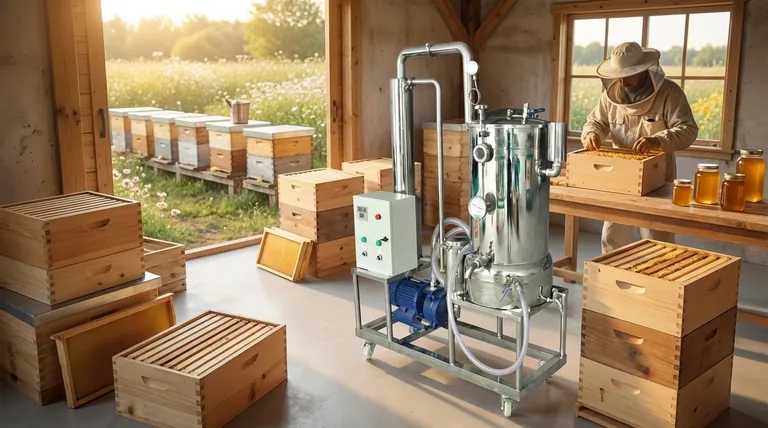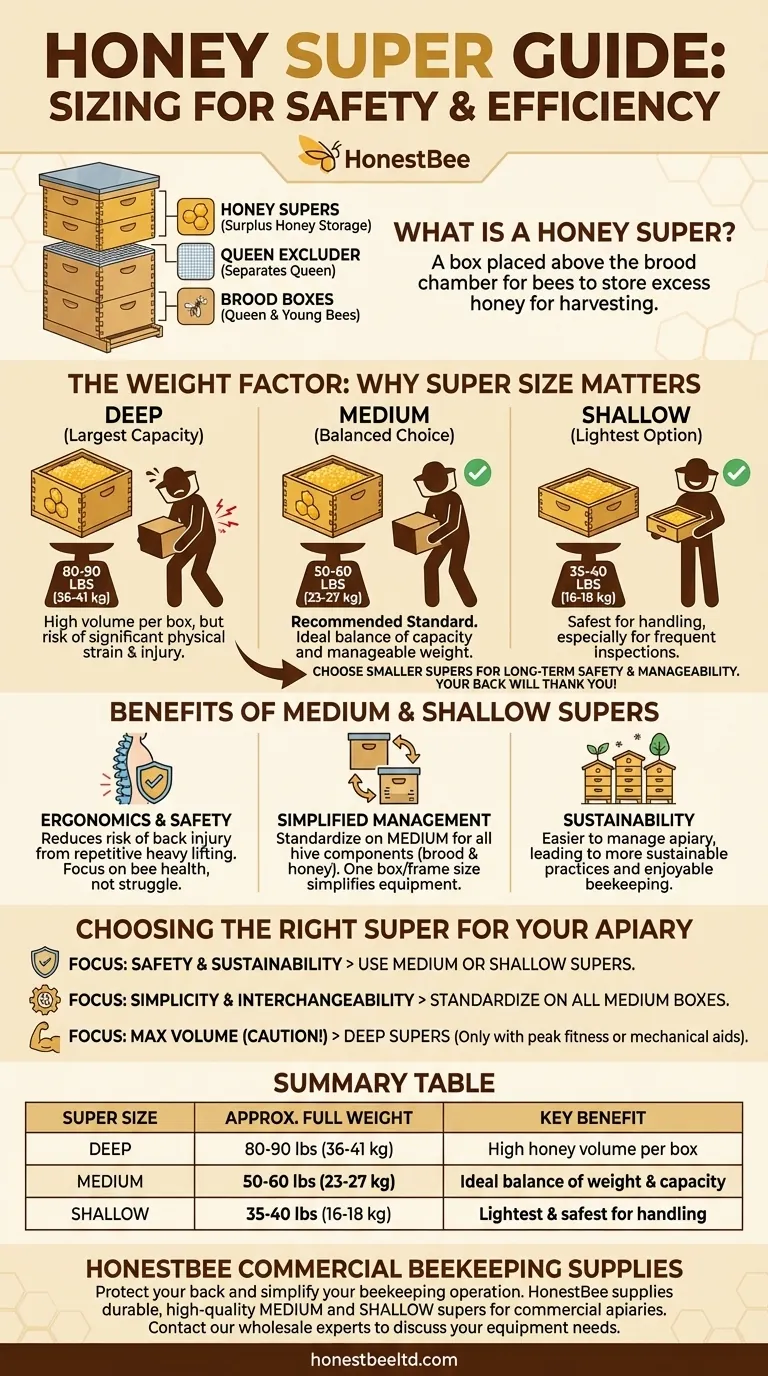In short, a honey super is a box placed on a beehive specifically for the bees to store surplus honey that you will harvest. Beekeepers overwhelmingly recommend medium or shallow-sized supers primarily for one practical reason: a full super of honey is deceptively heavy, and lifting a large, "deep" super can lead to significant physical strain and potential injury.
The decision of which honey super to use is not just about hive capacity; it is a fundamental choice about the long-term safety and manageability of your beekeeping practice. Your back will thank you for choosing smaller supers.

The Role of the Honey Super in Hive Architecture
A modern Langstroth beehive is a modular system of stacked boxes. Understanding the function of each box is key to effective management.
Separating Honey Storage from Brood Rearing
The lower boxes of a hive, known as brood boxes or hive bodies, are where the queen lays her eggs and the colony raises its young bees (the brood).
Honey supers are always added on top of the brood boxes. Their sole purpose is to provide space for bees to store excess honey once they have filled their primary stores in the brood chamber.
The Function of the Queen Excluder
To ensure the honey super contains only honey, many beekeepers place a queen excluder between the top brood box and the first honey super.
This device is a simple grid with openings large enough for worker bees to pass through but too small for the larger queen. This guarantees the queen cannot lay eggs in the honey supers, which makes for a much cleaner and simpler harvest.
The Critical Factor: Why Super Size Matters
While all hive boxes come in standard lengths and widths, they are available in three common heights: deep, medium, and shallow. The choice has significant ergonomic consequences.
The Unforgiving Weight of Honey
Honey is dense, weighing approximately 12 pounds per gallon. This adds up quickly inside a hive box.
- A deep super, when full of honey, can weigh 80-90 pounds (36-41 kg).
- A medium super weighs a more manageable 50-60 pounds (23-27 kg).
- A shallow super is the lightest, weighing 35-40 pounds (16-18 kg).
Ergonomics and Beekeeper Safety
Hive inspections and harvesting require you to lift and move these boxes repeatedly. Lifting an 80-pound box from a potentially awkward, bent-over position is a primary cause of back injury among beekeepers.
Choosing medium or shallow supers transforms a difficult task into a manageable one, allowing you to focus on the health of your bees rather than the physical struggle. This is why they are the standard recommendation for honey production.
The Advantage of Interchangeability
Many beekeepers choose to standardize their entire operation on all medium boxes. While this means the brood chamber will consist of three medium boxes instead of two deeps, it creates a system where every box and frame is interchangeable.
This simplifies equipment needs, as you only need to purchase, build, and store one size of box and frame for your entire apiary.
Understanding the Trade-offs
While the recommendation for smaller supers is strong, it's useful to understand the complete picture.
The Lure of Deep Supers
The main argument for using deep supers for honey is efficiency in volume. You can collect more honey per box, meaning you handle fewer total boxes during a major honey flow.
However, this efficiency is a trade-off that comes at the high cost of extreme weight. This approach is only viable for beekeepers who are in peak physical condition or who use mechanical lifting aids.
The Reality of Medium and Shallow Supers
The primary "disadvantage" of using smaller supers is that you will need more of them to hold the same amount of honey. During a strong honey flow, you may need to stack three or four medium supers where you might have used two deeps.
This means a slightly higher initial equipment cost and more boxes to inspect. For nearly all beekeepers, this is a minor inconvenience when weighed against the risk of injury.
Making the Right Choice for Your Apiary
Your equipment choices should align directly with your physical abilities and management goals.
- If your primary focus is safety and long-term sustainability: Use medium or shallow supers for all honey collection without exception.
- If your primary focus is simplicity and interchangeable equipment: Standardize your entire hive on medium supers for both brood and honey.
- If your primary focus is maximizing volume per box: You can consider deep supers, but only if you are fully aware of and physically prepared for the 80+ pound lifts required.
Choosing equipment you can manage with confidence is the foundation of a successful and enjoyable beekeeping journey.
Summary Table:
| Super Size | Approx. Weight When Full | Key Benefit |
|---|---|---|
| Deep | 80-90 lbs (36-41 kg) | High honey volume per box |
| Medium | 50-60 lbs (23-27 kg) | Ideal balance of weight & capacity |
| Shallow | 35-40 lbs (16-18 kg) | Lightest & safest for handling |
Protect your back and simplify your beekeeping operation. HONESTBEE supplies commercial apiaries and beekeeping equipment distributors with durable, high-quality medium and shallow supers designed for safety and efficiency. Let us help you build a sustainable and manageable apiary. Contact our wholesale experts today to discuss your equipment needs and get a quote!
Visual Guide

Related Products
- Honey Concentrating Vacuum Heating Thickening Machine Dehumidifier for Honey
- High Quality Honey Dehumidifier Dryer Thickening Machine for Beekeeping
- Professional Thermostatic Conical Honey Melter
- Economy Small Scale Honey Dryer Dehumidifier Thickening Machine
- No Grafting Queen Rearing Kit: System for Royal Jelly Production and Queen Rearing
People Also Ask
- What is required for the cooling system when using circulating water in the honey vacuum thickener? Essential Components for Efficient Processing
- How is the cooling system configured when using tap water in the honey vacuum thickener? A Simple Guide for Beekeepers
- What is the effect of excess moisture on honey's nutrients? Preserve Quality and Prevent Spoilage
- What are the benefits of motorized honey extractors? Save Time & Labor in Your Apiary
- What are the benefits of a honey concentrator? Elevate Your Honey Quality and Market Value



















